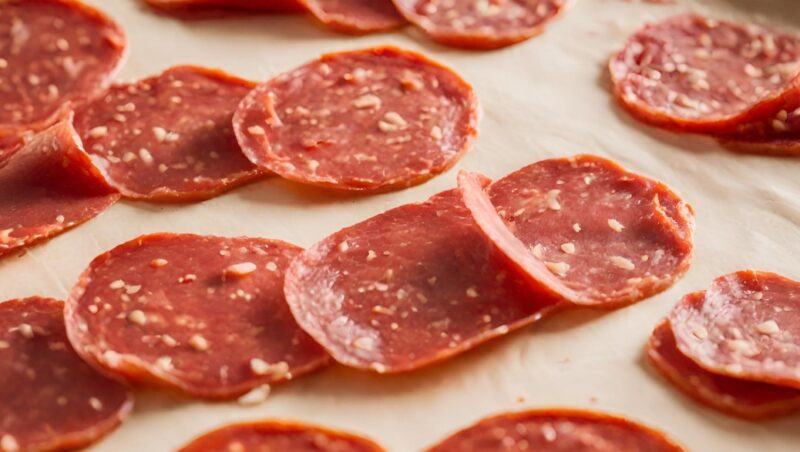The question “Can you eat raw pepperoni?” might have crossed your mind, especially if you’re a fan of this popular sausage (I know I am). In this straightforward exploration, we will provide you with a clear and concise answer to this culinary query.
No need to delve into complex details; we’ll tackle this topic head-on and provide you with valuable insights. So, let’s satisfy your curiosity and get straight to the point.
Is It Safe to Eat Raw Pepperoni?

The unequivocal answer is yes. The curing and preservation process that this sausage undergoes makes it safe for consumption without cooking. The combination of salts, spices, and fermentation effectively eliminates harmful pathogens, ensuring that this sausage is a low-risk food when consumed in moderation.
Production Process
Step 1: Meat Selection
The primary ingredients in pepperoni are beef and pork. The selection of high-quality cuts of meat is essential to ensure a flavorful end product. The meat is typically chosen for its balance of lean meat and fat content, as this contributes to the sausage’s texture and taste.
Step 2: Grinding and Mixing
Once the meat is selected, it goes through a grinding process. This involves passing the meat through grinding plates to achieve the desired consistency. After grinding, the meat is mixed thoroughly with various seasonings and spices.
Key ingredients include paprika, red pepper flakes, garlic, salt, and black pepper. These spices are responsible for pepperoni’s signature spicy and smoky flavor.
Step 3: Curing and Fermentation

After mixing, the meat blend is allowed to undergo curing and fermentation. This phase is crucial for flavor development and preservation. The meat mixture is stuffed into casings, typically made of natural or synthetic materials.
The sausages are then hung in a controlled environment with specific temperature and humidity levels. During this time, beneficial bacteria cultures are introduced, which aid in the fermentation process.
This step can take several days, during which the flavors mature and the sausage becomes safe for consumption.
Step 4: Smoking
To achieve the characteristic smoky flavor of pepperoni, the sausages are often smoked. They are placed in smokehouses where they are exposed to low heat and smoke from burning hardwood chips. The smoking process can last several hours, infusing the sausages with a rich, smoky aroma and flavor.
Step 5: Drying and Aging
After curing, fermentation, and smoking, the sausages are left to dry and age. This further enhances the texture and flavor profile. The drying and aging period can vary depending on the desired end product.
Some pepperoni is meant to be consumed relatively quickly, while others are aged for extended periods, intensifying their flavor.
Step 6: Slicing and Packaging
Once the sausages have reached the desired texture and flavor, they are sliced into thin rounds using specialized machines. These slices are then packaged for distribution to consumers and food establishments.
The packaging is typically airtight to preserve the freshness and flavor of the pepperoni.
The Taste Test: What to Expect

When you take that first bite of raw pepperoni, you’ll be met with a burst of intense flavors. Its taste is undeniably bold, with a delightful blend of spiciness, saltiness, and smokiness. These qualities, which are characteristic of cooked pepperoni, are just as present in the raw version.
Versatility in Culinary Creations
Raw pepperoni’s robust flavor opens the door to culinary creativity. You can incorporate it into a variety of dishes beyond the typical pizza topping. Try adding thin slices of this sausage to your salads, sandwiches, or charcuterie boards.
Potential Risks and Considerations

While raw pepperoni is generally safe to eat, it’s essential to be aware of some potential risks and factors to consider when including it in your diet.
Moderation is Key!
Raw pepperoni’s deliciousness can be tempting, but remember that it tends to be salty. Consuming it in moderation is crucial, as excessive salt intake can lead to health issues. A few slices can add a punch of flavor to your dish without going overboard.
Food Allergies and Sensitivities
For individuals with food allergies or sensitivities, it’s essential to check the ingredient list on the packaging. Some pepperoni brands may include ingredients that could trigger allergies or sensitivities, such as gluten or specific spices.
Always read labels and consult with a healthcare professional if you have concerns.
FAQs
Is pepperoni always made from beef and pork?
While beef and pork are the most common meats used in sausage production, some varieties may use alternative meats like turkey or chicken. These variations offer a different flavor profile while still capturing the essence of traditional pepperoni spices.
Can I make pepperoni at home?
Yes, it is possible to make it at home. However, it involves a complex curing and fermentation process, and precise temperature and humidity control, which can be challenging for beginners. It’s advisable to start with simpler sausage recipes before attempting homemade pepperoni.
Are there any regional variations of pepperoni?
Yes, for example, in some regions of the United States, you may find a spicier and drier pepperoni, while others offer a milder and moister version. These regional differences reflect local preferences and traditions.
How long does the aging process for pepperoni typically last?
The length of the aging process can vary widely. It can be as short as a few weeks or extend to several months or even years for some artisanal varieties. The duration of aging significantly impacts the flavor and texture of the final product.
Can I freeze pepperoni for long-term storage?
Yes, you can. Ensure it’s properly sealed in an airtight container or freezer bag to prevent freezer burn. When thawed, the texture and flavor may slightly change, but it’s still safe to consume and use in dishes.
Are there any vegetarian or vegan alternatives to pepperoni?
Yes, there are vegetarian and vegan alternatives. These alternatives often use plant-based ingredients like soy, seitan, or mushrooms to replicate the flavor and texture of pepperoni. They offer a cruelty-free option for those who prefer not to consume meat.
Conclusion
In conclusion, the question of whether you can eat raw pepperoni has a resounding “yes” as the answer. It’s not only safe but also surprisingly flavorful. Raw pepperoni’s spicy, salty, and smoky notes can elevate your culinary creations in various ways.
Just remember the importance of moderation and awareness of your individual dietary needs and preferences. Surprisingly, this kind of sausage offers a world of culinary possibilities for those willing to explore, adding a delightful twist to your dining experience. So, go ahead, savor a slice or two, and enjoy the distinct and bold flavors.

